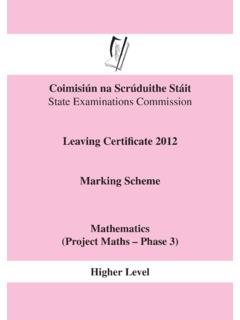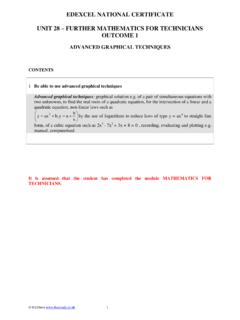Transcription of 2012 Leaving Cert Higher Level Official Sample Paper 1
1 2012 Leaving cert Higher LevelOfficial Sample Paper 1 Section AConcepts and Skills150 marksQuestion 1(25 marks)(a)w= 1+ 3iis a complex number, wherei2= 1.(i)Writewin polar have|w|= ( 1)2+ 32= 4=2. Also, ifarg(w) = , then tan( ) = 3 1= 3 and lies inthe second quadrant (from the diagram). Therefore =tan 1( 3) =2 3radians. Sow=2(cos2 3+isin2 3)Im(z)Re(z)w(ii)Use De Moivre s Theorem to solve the equationz2= 1+ 3i. Give your answer(s)in rectangular that the polar form ofzis given byz=r(cos +isin ). Then[r(cos +isin )]2=2(cos2 3+isin2 3)By De Moivre s Theorem this is equivalent tor2(cos(2 )+isin(2 )) =2(cos2 3+isin2 3).Thereforer2=2 and 2 =2 3+2n ,n Z.
2 Sor= 2 and = 3+n . We get two distinctsolutions (corresponding ton=0 andn=1).z1= 2(cos 3+isin 3)= 2(12+i 32)=1 2+i 32andz2= 2(cos( 3+ )+isin( 3+ ))= 2( 12 i 32)= 1 2 i 32(b)Four complex numbersz1,z2,z3andz4areshown on the Argand diagram. They satisfy thefollowing conditions:z2=iz1z3=kz1,wherek Rz4=z2+z3 The same scale is used on both axes.(i)Identify which number is which by labellingthe points on the diagram.(ii)Write down the approximate value :12z3z1z2z4 Explanation: Multiplication byirotates a complex number by 90 anticlockwise about theorigin - soz2is obtained by rotatingz1through 90 about the , we must have 0,z1andz3being +z3, we must have 0,z2,z4andz3forming a 2(25 marks)(a)(i)Prove by induction that, for anyn, the sum of the firstnnatural numbers isn(n+1) we check that the statement is true forn=1.
3 The sum of the first 1 natural numbers is1, and whenn=1 we haven(n+1)2=1(1+1)2=22=1. So the statement is true forn= suppose that the statement is true for somen 1. So1+2+ +n=n(n+1) , addn+1 to both sides and we get1+2+ +n+(n+1) =n(n+1)2+(n+1)=n(n+1)2+2(n+1)2=n(n+1)+2( n+1)2=(n+2)(n+1)2=(n+1)(n+2)2So the sum of the firstn+1 natural numbers is(n+1)((n+1)+1)2, which completes the inductionstep. Therefore, by induction, the statement is true for all natural numbersn.(ii)Find the sum of all the natural numbers from 51 to 100, part (i), we know that1+2+ +100=100(101)2= also know that1+2+ +50=50(51)2= the second equation from the first yields51+52+ +100=5050 1275=3775.
4 (b)Given thatp=logcx, express logc x+logc(cx)in terms know thatlogc x=logcx12=12logcx=12pusing the power law for ,logc(cx) =logcc+logcx=logcc+pusing the product rule for logcc=1 sincec1=c. Thereforelogc x+logc(cx) =12p+1+p=3p2+ 3(25 marks)A cubic functionfis defined forx Rasf:x7 x3+(1 k2)x+k,wherekis a constant.(a)Show that kis a root kforxwe obtainf( k) = ( k)3+(1 k2)( k)+k= k3 k+k3+k=0 Therefore kis a root off.(b)Find, in terms ofk, the other two roots kis a root offwe know, by the Factor Theorem, that(x+k)is a factor off(x).Now we carry out long division to find the other kx+1x+k)x3+0x2+ (1 k2)x+kx3+kx2 kx2+ (1 k2)x kx2 k2xx+kx+k0 Sox3+(1 k2)x+k= (x+k)(x2 kx+1).
5 Therefore the other two roots offare solutions of the equationx2 kx+1= the quadratic formula we getx=k k2 the other two roots offarek+ k2 42andk k2 42.(c)Find the set of values ofkfor whichfhas exactly one real the solution to part (b), we see thatfhas exactly one real root if and only ifk2 4< is equivalent tok2<4 or 2<k<2 Question 4(25 marks)(a)Solve the simultaneous equations:2x+8y 3z= 12x 3y+2z=22x+y+z= can subtract the second equation from the first:2x+8y 3z= 12x 3y+2z=211y 5z= 3 Similarly, we subtract the third equation from the first:2x+8y 3z= 12x+y+z=57y 4z= 6 Now we solve the simultaneous equations11y 5z= 37y 4z= 6 Multiply the first by 7, the second by 11 and subtract:77y 35z= 2177y 44z= 669z=45 Thereforez=459=5.
6 Now substitutez=5 into 7y 4z= 6 to get 7y 4(5) = 6 or7y= 6+20=14 Thereforey= substitutey=2 andz=5 into 2x+8y 3z= 1 to get 2x+8(2) 3(5) = 1 or2x= 1 8(2)+3(5) = 2 Sox= the solution isx= 1,y=2,z= we can check this by substituting into the original equations and verifying that they areall true:2( 1)+8(2) 3(5) = 12( 1) 3(2)+2(5) =22( 1)+(2)+(5) =5.(b)The graphs of the functionsf:x7 |x 3|andg:x7 2 are shown in the diagram.(i)Find the co-ordinates of the pointsA,B, on they-axis, so itsx-co-ordinateis 0. Nowf(0) =|0 3|=| 3|= (0,3).C= (,0)(on thex-axis), so we solve|x 3|=0 to find |x 3|=0 x 3=0 x= (3,0).AandBboth havey-co-ordinate 2, sowe solve|x 3|=2.
7 Now|x 3|=2 (x 3) =2. So either(x 3) =2 or (x 3) = the first casex=5 and in the secondcase x+3=2 orx=1. SoA= (1,2)andB= (5,2).A= (1,2)B= (5,2)C= (3,0)D= (0,3)y=f(x)y=g(x)CABD(ii)Hence, or otherwise, solve the inequality|x 3|< solution set of the inequality corresponds to the values ofxfor which the graph offisbelow the graph ofg. From the diagram and calculations above, we see that the solution setis1<x< 5(25 marks)Ais the closed interval[0,5]. That is,A={x|0 x 5,x R}.The functionfis defined onAby:f:A R:x7 x3 5x2+3x+5.(a)Find the absolute maximum and minimum values we calculate the derivative off. Sof (x) =3x2 5(2x)+3(1)+0=3x2 10x+3 Now we solvef (x) =0 to find the stationary points off.
8 Now3x2 10x+3=0 x=10 102 362(3) x=10 the stationary points off(x)are given byx=3 orx= both of these lie insideA. So the maximum/minimum value off(x)occurs at onex=0,13,3 or 5. Nowf(0) =5f(13) =127 59+1+5=14827f(3) =27 5(9)+3(3)+5= 4f(5) =125 5(25)+3(5)+5=20 ThereforeThe maximum value offis 20andThe minimum value offis 4(b)State whetherfis injective. Give a reason for your NOT : We see from our solution to part (a) thatf(13)>0>f(3)- in particular the signoff(x)changes betweenx=13andx=3. This means that there is somea<3 such thatf(a) =0 Similarly, sincef(3)<0<f(5), there is someb>3 such thatf(b) = <0 andb>0, butf(a) =f(b) =0.
9 Thereforefis not 6(25 marks)(a)(i)Write down three distinct anti-derivatives of the functiong:x7 x3 3x2+3,x :x7 14x4 x3+ :x7 14x4 x3+3x+ :x7 14x4 x3+3x+6.(ii)Explain what is meant by the indefinite integral of a indefinite integral offis the general form of a function whose derivative answer: The indefinite integral offisF(x)+CwhereF =fandCis constant(the constant of integration).(iii)Write down the indefinite integral ofg, the function in part(i).Answer: g(x)dx=14x4 x3+3x+C.(b)(i)Leth(x) =xlnx, forx R,x> (x).Using the product rule we see thath (x) = (x) lnx+x(lnx) .But(x) =1 and(lnx) =1x. Thereforeh (x) = (1)lnx+x(1x)=lnx+1.
10 (ii)Hence, find know thath (x) =lnx+1. Also, we know that(x) =1. So ifF(x) =h(x) x, thenF (x) =h (x) (x) =lnx+1 1= lnx dx=F(x)+c. ButF(x) =h(x) x=xlnx x. Therefore lnx dx=xlnx x+ BContexts and Applications150 marksQuestion 7(50 marks)A company has to design a rectangular box for a new range of jellybeans. The box is to beassembled from a single piece of cardboard, cut from a rectangular sheet measuring 31 cm by 22cm. The box is to have a capacity (volume) of 500 net for the box is shown below. The company is going to use the full length and width of therectangular piece of cardboard. The shaded areas are flaps of width 1 cm which are needed forassembly.










